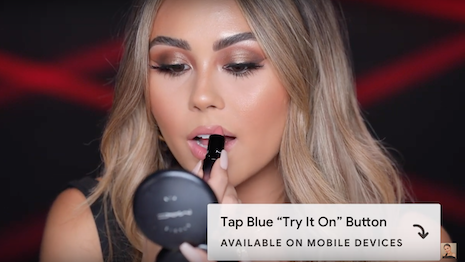 MAC Cosmetics is the first brand to launch augmented reality features on YouTube. Image credit: YouTube
MAC Cosmetics is the first brand to launch augmented reality features on YouTube. Image credit: YouTube
Google’s YouTube is adding a tech-forward touch to its popular beauty tutorials with the introduction of an augmented reality feature.
Initially launching as a partnership with M.A.C Cosmetics and vlogger Roxette Arisa, YouTube’s Beauty Try-On feature allows viewers to virtually test and shop lipsticks straight from a video tutorial. More platforms and luxury brands have been incorporating AR features, but YouTube’s implementation blends sponsored content with technology while having billions of viewers within reach.
YouTube beauty
YouTube first teased the launch of AR Beauty Try-On this June. The feature is available through Google’s in-house branded content platform, FameBit.
In the first video to debut with Beauty Try-On, M.A.C enlisted Ms. Arisa to created a sponsored tutorial using a new collection of lipsticks and other cosmetics from the brand. Ms. Arisa's YouTube channel has more than 1.1 million subscribers.
YouTube’s Beauty Try-On is only available on its mobile app
Viewers can use the AR feature on YouTube’s mobile application. When activated, a front-facing camera will open so consumers can virtually try-on the different lip colors on themselves as the tutorial continues playing in a split-screen view.
In earlier tests with several beauty brands, 30 percent of users engaged with the AR experience, according to Google. On average, consumers spent more than 80 seconds virtually trying on lipsticks.
It is expected that more beauty brands will partner with FameBit to work with influencers and engage viewers with AR try-on.
Fashion label Marc Jacobs is one luxury brand that has consistently worked with YouTube celebrities, such as naming makeup artist and vlogger Nikkie de Jager as its global artistry advisor. The Kendo-produced makeup line has previously worked with vloggers tapping into the influential power of YouTube celebrities, but this appointment marked a further investment in digital content (see story).
YouTube has more than 2 billion active monthly users and has a robust influencer community. The platform was once the leading influencer channel among beauty brands, before being surpassed by Instagram in 2018 (see story).
Nonetheless, Generation Z in particular has shown a strong affinity for YouTube. These consumers use the platform to discover new television, music and influencers.
YouTube is the most popular platform among users ages 18 to 24, per data from Visual Objects. According to GenHQ, 47 percent of Gen Zers view more than three hours of content on YouTube on a daily basis (see story).
Luxury AR
The beauty industry, including luxury brands, has been at the forefront of bringing AR uses to the masses.
For instance, Italian fashion label Giorgio Armani catered to the growing online market for beauty in China by becoming the first luxury brand to incorporate 3D augmented reality makeup try-ons into its WeChat mini program.
Beauty group L’Oréal’s AR makeup platform ModiFace will be supporting Armani Beauty’s virtual makeup application on WeChat, one of the leading social media platforms in China. Armani Beauty’s AR try-on is meant to mimic the virtual mirrors that are becoming more commonplace in Chinese bricks-and-mortar stores (see story).
LVMH’s Sephora brought AR technology to a wide audience through its own app feature that enables users to virtually try on different lip color shades.
An app update launched the Sephora Virtual Artist feature, which was specifically designed using facial recognition software to allow users to test lip products and purchase directly in the app. While there have been a slew of beauty brands and startups innovating in the augmented reality space, Sephora’s recent integration brought the strategy further into the mainstream makeup world (see story).